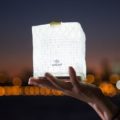GravityLight, a sustainable light source that requires no electricity, not even solar power, could change the lives of the 1.2 billion people around the world who are currently living off the grid.
It’s such a simple idea on paper that it’s surprising no one thought of it sooner. A 12kg weight is manually winched into the air on a pulley, and as it slowly falls to the ground, it powers an LED lamp that generates 20 minutes of light at a time. When the weight hits the ground, the user simply lifts it up again with the pulley.
The goal – cheap, sustainable light
UK-based designers Martin Riddiford and Jim Reeves came up with the concept after SolarAid – a non-profit organisation that combats poverty and climate change – commissioned them to develop a cheap, sustainable new light source to help people in developing countries who don’t have access to electricity.
Those 1.2 billion people often have to rely on dangerous and expensive kerosene lamps to light their homes. They are often rudimentary homemade constructions, little more than a bottle or tin can filled with fuel and a wick to light.
They are not a sustainable solution. They offer little light, emit toxic black smoke, and are incredibly expensive for the families that use them. Kerosene use has also been associated with low birth weight and neonatal death. GravityLight offers a clean, safe alternative to this.
SolarAid have spent the last decade providing access to solar lamps to people in Malawi, Uganda and Zambia, but when Martin Riddiford and Jim Reeves came to design their light, they found that the photovoltaic panels and batteries required by solar lamps were their most expensive components. By eliminating these, they believed they could make the lamps significantly cheaper.
First designs and funding
This is where the concept for GravityLight was born. SolarAid’s initial approach came in 2009, and by 2012 the designers had a working prototype. The next step was to prove that it worked in the real world.
Through crowdfunding campaigns, they raised enough money to be able to test the lights across 26 different countries, and after gathering all the feedback and results, they piloted an updated model in Kenya in 2015.
This cycle of production, distribution and feedback has allowed the designers to continually refine their invention and work out some of the issues the earlier builds faced. Their first aim was to improve the life of the products, but later on in the development process, they had some technical issues to overcome.
For example, they found a flaw where the pulley’s beaded cord would get tangled in the light’s mechanism. As they acknowledged in a blog post in 2016, the designers found this unacceptable, “particularly as GravityLight will be the only light source in many homes. It is unreasonable to expect users to resolve tangles as severe as these, especially in the dark.”
After more refinements and rigorous testing, the bead cord problem was completely resolved and GravityLight was introduced to Kenya in late 2016. In July 2017, the designers of GravityLight were recognised for their achievement at the Cannes Lions International Festival of Creativity, winning awards in the Health, Innovation and Product Design categories.
Where next for GravityLight?
One of the biggest challenges that the GravityLight team face, they say, is selling the benefits of such an unfamiliar technology. They partly rely on word of mouth and product demonstrations to show what GravityLight can do. It is simple to operate, but might not look like it to people who have never seen it before.
The designers also have one eye on quality, while still working to fulfil the brief that the lights need to be as inexpensive as possible. The end product is a lamp that is functional without looking cheap.
It is still early days as far as the distribution of GravityLight goes, but the team are already looking at ways to expand upon the product. In late 2016, they released details of additional ‘SatLights’ that connect to the main lamp to spread light further around a room.
The eventual aim of GravityLight is to scale up international production to reach those 1.2 billion people without electricity.
The GravityLight Foundation is a UK registered charity.




